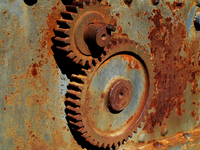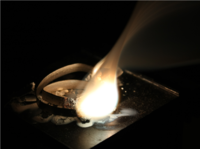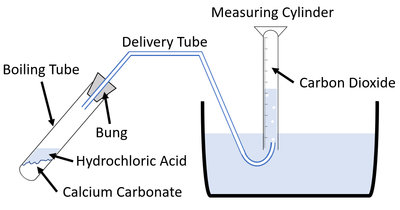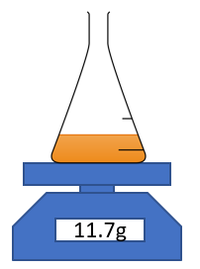Difference between revisions of "Rate of Reaction"
| Line 44: | Line 44: | ||
{| class="wikitable" | {| class="wikitable" | ||
|- | |- | ||
| − | |[[File:MeasuringOpacity.png|center| | + | |[[File:MeasuringOpacity.png|center|200px]] |
|- | |- | ||
| − | | style="height:20px; width:200px; text-align:center;" |This [[diagram]] shows a possible setup for identifying when a [[mixture]] becomes [[opaque]] during a [[Chemical Reaction|reaction]]. | + | | style="height:20px; width:200px; text-align:center;" |This [[diagram]] shows a possible setup for identifying when a [[mixture]] becomes [[opaque]] during a [[Chemical Reaction|reaction]] by drawing a black cross on a white tile and [[observe|observing]] until the cross can no longer be seen. |
|} | |} | ||
Revision as of 12:10, 16 January 2019
Contents
Key Stage 4
Meaning
Rate of reaction is a measure of how quickly the reactants react to create the products.
About the Rate of Reaction
- The longer the time taken for a reaction the lower the rate of reaction. The shorter the time taken for a reaction the higher the rate of reaction.
- High rates of reaction are important to in industries where a lot of products are needed in a short amount of time. This can save money.
- Low rates of reaction are important in materials that corrode with chemicals in the environment. This allows them to last a long time before destroyed by Oxidation or chemical weathering.
Examples
| Rusting has a low rate of reaction. | Burning Magnesium ribbon has a high rate of reaction. |
Determining the Rate of Reaction
There are two approaches to finding the rate of reaction for some chemicals.
Continuously Measuring Volume of Gas
For reactions which give off a gas the volume of gas produced can be measured throughout an experiment to find the rate of reaction.
| This diagram shows a possible setup for measuring the gas given off during an experiment. |
Continuously Measuring the Mass
For reactions which give off a gas the mass of reaction mixture can be measured throughout an experiment to find the rate of reaction.
| This diagram shows a possible setup for measuring the mass of the reaction mixture during an experiment. |
Continuously Measuring the Opacity
For reactions in which the reactants are in a transparent solution but the products form an insoluble precipitate that is opaque then the opacity can be measured.
| This diagram shows a possible setup for identifying when a mixture becomes opaque during a reaction by drawing a black cross on a white tile and observing until the cross can no longer be seen. |




